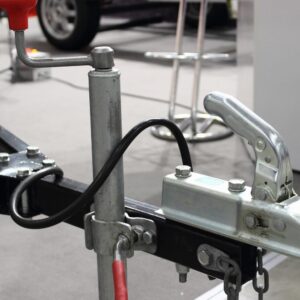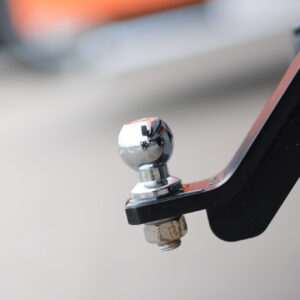A drop hitch receiver or drop hitch is a piece of equipment that allows trucks or SUVs to mount a trailer. Crucially, a drop hitch receiver can raise or lower the tongue, which is the metal ball where trailers mount. This adjustability can allow your vehicle to connect to trailers that have a low coupler while being level with the vehicle.
The alignment between your vehicle’s drop hitch’s tongue and the trailer’s coupler is critical. A misaligned coupler can cause a trailer to tilt upward or downward, which can be unsafe, as it puts stress on the vehicle’s towing system and causes the vehicle to be unstable. If your vehicle’s drop hitch tongue is significantly lower than the trailer’s coupler, then you might not be able to mount the trailer at all.
How To Choose the Right Drop Hitch Receiver
Before you attach a trailer hitch drop receiver to your vehicle, you’ll need to ensure that your vehicle can handle the trailer’s weight. Vehicles have a prescribed maximum towing weight, which can be found in your owner’s manual. Once you’ve found your vehicle’s maximum towing weight, cross-reference it with your trailer’s weight. Once you know that your vehicle can tow the trailer, you’ll need to choose a drop hitch receiver that can also tow the trailer.
Tow hitch receivers have categories that are determined by their maximum gross trailer weight (GTW). GTW is the combined weight of the trailer and its contents.
- Class 1 – 1,000 to 2,500 pounds
- Class 2 – 3,500 pounds
- Class 2.5 – 4,000 pounds
- Class 3 – 6,000 pounds
- Class 4 – 8,000 pounds
- Class 5 – 10,000 pounds
How To Find the Hitch Retriever Drop Measurement
Assuming you’ve mounted the appropriate trailer hitch on your vehicle, you’ll then want to determine the drop measurement, which is the distance between your vehicle’s receiver tube and the trailer’s coupler. You’ll need to determine this distance to ensure that you’re using the correct hitch receiver with the correct height.
The first thing that you need to measure is the distance between the ground and your vehicle’s receiver tube, which is the tube where the drop hitch is inserted. Using measuring tape is ideal. Make sure that you measure the distance from the ground to the top inside edge of the receiver tube, as this is the measurement you’ll need.
Then you’ll need to measure the distance between the trailer coupler and the ground. Ensure that the trailer is level with the ground before doing this.
After accurately measuring and recording the receiver and coupler heights, subtract the coupler height from the receiver height to calculate the drop or rise number.
Once you have your drop or rise number, you’ll have what you need to be able to choose the correct drop hitch receiver that will fit your vehicle and trailer.

How To Use a Drop Hitch Receiver
Using a drop hitch receiver can be broken down into two parts:
Installing the Drop Hitch Receiver
To install the drop hitch receiver, you’ll need to slide the hitch into your vehicle’s receiver tube and secure it with the hitch pin. To do this properly, you need to ensure that the receiver tube is free of debris. You’ll also need to align the drop hitch’s pinhole with the receiver tube’s pinhole to secure it with the hitch pin.
Attaching a Trailer
To mount your trailer onto your vehicle, you’ll need to lower the trailer’s coupler onto the tongue or ball mount and ensure it locks securely. Most trailer couplers have a locking mechanism that you need to engage.
Check if the trailer is level with your vehicle. You can do this by using a level or just by eyeballing it. Then, you’ll need to connect the trailer’s safety chains to your vehicle so that they crisscross and form an “X” beneath the trailer tongue. You also have to make sure that the chains don’t have too much slack to the point that they’re rubbing on the ground.
Most trailers also have a wiring harness that allows the trailer’s brake lights to work in conjunction with the vehicle. After connecting the wiring harness, ensure that the trailer’s running lights, brake lights, and turn signal lights are working properly.
Advantages of Using a Drop Hitch Receiver
Some receiver hitches can drop down and offer varying levels of vertical adjustment. Variable trailer hitches offer distinct advantages over fixed hitches because they can allow you to level your trailer’s connection without getting another hitch with a different drop measurement. Changing the tongue’s drop height can be as simple as removing the pins that hold it in place, moving the tongue to its ideal position, and putting the pins back in place. Variable trailer hitches can be good if you use your truck for various trailers that have different trailer coupler heights.
Overall, using a drop hitch receiver isn’t simple, as there are a lot of things to remember. That said, remembering these steps is critical if you want to keep your trailer aligned with your vehicle and safely tow your trailer.
Any information provided on this Website is for informational purposes only and is not intended to replace consultation with a professional mechanic. The accuracy and timeliness of the information may change from the time of publication.















